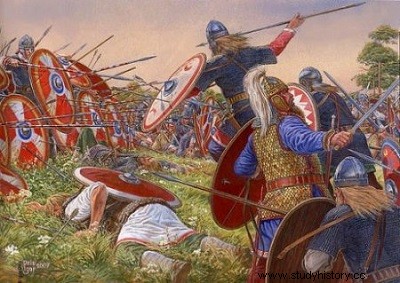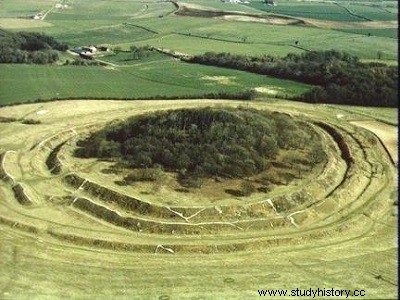
The Battle of Mount Badon (Mons Badonicus in Latin, Mynydd Baddon in Welsh) is a battle won by the Bretons over the Anglo-Saxons around the year 500, during the Anglo-Saxon conquest of Brittany.
The King Arthur myth surrounding the battle, as well as the scant and conflicting information that has come down to us about this clash, means that no explanation is completely validated.
First Mentions
Gildas the Wise († 570) mentions the “siege of Mount Badonicus” without giving details in § 26 of his sermon De Excidio et Conquestu Britanniae; he seems to consider this fact as an important event, occurring the year of his birth 43 years before the writing of the text, but does not speak of King Arthur at all, neither there nor anywhere in his text. Bede the Venerable mentions the battle in his Ecclesiastical History of the English People (completed in 731), but he does so by repeating Gildas' text verbatim; there too, it is not a question of King Arthur. In the Historia Brittonum (compilation dated from the ninth century in the form that has come down to us), King Arthur makes his appearance, and the battle of Mount Badon is presented as one of the twelve that he fought against the Saxons. Then the battle appears in the Annals Cambriae in the year 516, as a victory attributed to King Arthur.
Battle location

We do not know with certainty the place where it took place. Several hypotheses, which place it in England, Wales or even near Scotland, are proposed:
Bath, Somerset. A site suggested by Geoffrey of Monmouth, Bath was known to the Saxons as Baþon, Baðon, and Baðanceaster. The battle would obviously take place in the vicinity of Bath, on one of the surrounding hills, without it being possible to specify the exact location, the city not being the epicenter of the confrontation. The word "bath" is of Germanic origin, but "Badon" is a word of Celtic origin. Under the Romans, Bath was known as Aquae Sulis, but the site (and nearby Solsbury Hill) was already populated long before the Romans arrived.
Badbury Hillfort / Badbury Rings, an Iron Age oppidum (fortified hill) in Dorset.
Mynydd Baedan, South Wales,
Buxton, spa town Derbyshire.
Liddington Castle, a Bronze Age and Early Iron Age oppidum in Wiltshire.
Uncertainties about the actors and protagonists
In the 9th century, the historian Nennius in his Historia Brittonum attributed this victory to King Arthur. He writes that at Mons Badonis, "in one day, nine hundred and sixty men were killed by the assault of Arthur's warriors and none other than him defeated them". On the other hand, the 10th century Welsh monks who composed the Annales Cambriae speak of "the battle of Badon, in which Arthur carried on his shoulders the cross of our Lord Jesus Christ for three days and three nights and the Britons were victorious". Gildas the Wise does not mention Arthur's presence at the battle, nor does he attribute the victory to Ambrosius Aurelianus, whose life predates the estimate made of the date of the battle. The fact that the monk Gildas does not specify the name of the winner of the battle of Mount Badon, the fact that he does not attribute it to Arthur (or to anyone in particular for that matter) when the majority of later accounts do, even though Gildas would be a contemporary of Arthur (and should therefore have paid tribute to him for this victory), constitutes a great mystery and makes Arthur elusive. This is one of the major reasons that make historians doubt the existence of the legendary Arthur.
The Saxon army is said to have been led by Ælle of Sussex or Cerdic of Wessex, or perhaps by both at once, suggesting a coalition of Angle and Saxon forces to attempt to crush the Breton forces definitively and reach the Severn Sea to isolate the Welsh from the southern Bretons.
Details on the date
The Annals Cambriae date the battle to 516.
Gildas, in the De excidio Britanniæ (§ 26) says to write 43 years after the battle:"From that day a month has elapsed of the forty -fourth year, and it is also the year of my birth”. To interpret this indication, it would be necessary to be able to date the text. In § 33, Gildas attacks in the second person and in the present a tyrant Maglocunus, described as an "island dragon", who is very probably the king called in Welsh Mailcun, sovereign of the kingdom of Gwynedd (thus of the island of Anglesey), of whom the Annals Cambriæ tell us that he died of the plague in 547. We deduce that the De excidio Britanniæ is prior to this date, and the battle of Mount Badon (like the birth of Gildas) prior to 504.
Bede the Venerable (Ecclesiastical History of the English People, I, 16) mentions the battle of Mons Badonicus by repeating verbatim the words of De excidio Britanniæ by Gildas, but he adds an objective dating:“about the forty-fourth year after their arrival [sc. of the Anglo-Saxons] in Brittany” (same lapse of time as that which separates the battle from De excidio Britanniæ). However, in I, 15, he places this arrival in 449 or 450 (he writes "in the year of the Incarnation of the Lord 449", but says at the same time that it is the year of the advent of the Emperor Marcian, which took place on August 25, 450). So he places the battle of Mount Badon in 493 or 494, which is consistent with the chronological elements of De excidio Britanniæ.
Consequences
It is a major event in the political and military history of Great Britain. He stopped the Saxon invasion and allowed the resumption of territories previously lost by the Bretons. It was, however, as Gildas puts it, "the last, though not the least, massacre of our cruel enemies".
